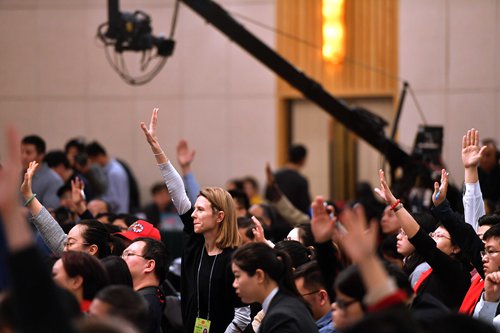
Reporters raise questions at a press conference at the ongoing two sessions in Beijing on Wednesday. Photo: VCG
Last year, many changes took place in the domestic field of civil aviation, including the introduction of a competition mechanism for international traffic rights, a lifted ban on in-flight electronic equipments - which now allows passengers to surf the internet onboard - as well as mixed-ownership reforms.
In the meantime, despite those innovative changes, a number of problems have surfaced, such as a high volume of flight delay complaints, the question of how to develop general aviation more quickly and efficiently as well as how to control unmanned aerial vehicles.
Luckily, delegates from the industry have been focusing their attention on these issues and questions during the ongoing two sessions, key annual meetings of China's top legislative and advisory bodies.
Liu Shaoyong, chairman of China Eastern Airlines, said in Beijing on Sunday that the company had submitted an application for group-level mixed ownership to the State-owned Assets Supervision and Administration Commission.
In June, Shanghai-based China Eastern Air Holding Co sold a 55 percent stake in its wholly owned Eastern Air Logistics (EAL) to four external investors and its core employees, in a move to lower EAL's debt ratio and increase its market competitiveness.
But China Eastern is not alone. Other State-owned airlines also joined in on the mixed-ownership reform craze last year. For example, in March 2017, American Airlines agreed to pay $200 million for a stake in China Southern Airlines, the biggest of China's three major State-owned carriers in terms of fleet size.
Liu said at the ongoing two sessions that such mixed ownership will better serve the country's economy and opening-up. In particular, it will help group companies to participate more competitively on a global scale.
In recent years, although the quality of civil aviation services across China have achieved good results, the contradiction between the rapid development of the industry and the insufficiency of resource support capabilities has become increasingly prominent.
Specifically, the impact of extreme weather on the normal operation of aircraft has been constantly increasing, causing more flight delays and post-delay service problems.
According to the five-year plan designed by the Civil Aviation Administration of China last year, the annual growth rate of the total volume of transportation and the volume of passenger traffic will increase by 10.8 percent and 10.4 percent, respectively, over the next five years, which is obviously higher than that of the national economy.
Airspace in China is primarily controlled by the military, although there has been progress to some extent in recent years. Against this backdrop, it is becoming increasingly important to adapt to the current development needs of national defense and civil aviation to further improve airspace resources.
Media reports noted that Chinese airlines transported 552 million passengers in 2017 on a total of 14,400 flights per day, up from just 4,600 flights per day in 2006, growing annually at 10.9 percent during that period. By contrast, the annual growth of space resources was only 2 percent during that same period, an imbalance which is leading the increase of delayed flights.
Wang Yu, chairman of Spring Airlines, China's largest budget carrier, made some suggestions to improve current airspace resources at the ongoing two sessions.
He suggested that it is necessary to increase routes and capacity of airspace as soon as possible, especially in airports with limited space.
He also said that it is necessary to gradually liberalize airspaces around hub airports, increase investment in new technology and new air traffic control equipment, as well as promote the reform of airspace resources.

